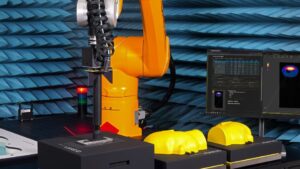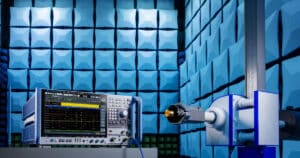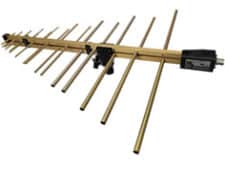As the semiconductor industry embraces the chiplet design approach, electrical engineers are witnessing a significant shift in how performance, cost efficiency, and scalability are achieved. While this modular design philosophy offers advantages, it also introduces challenges to signal integrity (SI). For EMI/EMC engineers, the awareness of these signal integrity challenges is … [Read more...]
SPEAG combines CMX500 OBT with the DASY83D system for automated SAR testing of 5G NR devices
SPEAG and Rohde & Schwarz expand their long-term collaboration with the combination of the CMX500 wideband radio communication tester with the DASY83D utilising the enhanced DASY8 Application Programming Interface. This combination allows manufacturers of wireless devices to perform Specific Absorption Rate tests of 5G FR1 devices using the future-proof CMX500 … [Read more...]
EMV 2025: Rohde & Schwarz Presents New Antenna for EMI Measurements in Frequency Range from 14.9 GHz to 44 GHz
At the EMV 2025 tradeshow in Stuttgart, Rohde & Schwarz displays for the first time its R&S HF1444G14 High-gain EMI microwave antenna with outstanding performance. The antenna covers a frequency range from 14.9 GHz to 44 GHz. It meets the requirements of the standards CISPR 16-1-4 and CISPR 16-2-3. Precise mechanical construction and optionally … [Read more...]
An Easy Way to Calculate a Microwave Wavelength in Inches
A colleague, Mike Stasiowski, and I came up with this quick GHz wavelength formula while designing quad ridge circular polarized jamming antennas for the military when working at Nurad. The textbook formula (wavelength = c/f) where: c = the speed of light 3.00×108 m/s, and f = frequency in Hz, was cumbersome at times to calculate, then convert, to inches for practical … [Read more...]
Antenna Factor Calculations and Deviations
Introduction In recent years, the use of a term call "Antenna Factor" in EMC and spectrum pollution work has become very important. There has been a great need for measuring field intensity and/or power density as accurately and conveniently as possible. Classically in RFI/EMI measurements, the use of antenna factors is very common. These antenna factors were, by … [Read more...]
Molex Unveils Extensive Line of Ruggedized EMI-Filtered Interconnects and RF Components to Bolster Support for Critical Aerospace and Defense Applications
Molex introduces a versatile selection of EMI-filtered interconnects and RF components, enhancing signal integrity and electromagnetic compatibility for critical aerospace and defense systems. Explore over 250 customizable configurations engineered for optimal reliability in challenging environments. New product portfolio with more than 250 configurations and countless … [Read more...]
Shielding Design Flow Chart
The flow chart in Table 1 will assist the designer in selecting the appropriate shielding options necessary to meet their shielding and environmental requirements. The shielding requirement flow chart begins by identifying the type of NEMA or IP enclosure based on the intended environment (indoor/outdoor, military/commercial, marine or land/desert). Then, using the resulting … [Read more...]
Some of the Many Stories of Medical EMI
Introduction I have been collecting stories about EMI for a long time, publishing many of them in the ‘Banana Skins’ column of The EMC Journal, www.theemcjournal.com. Some come from official reports, some from anonymous whistleblowers, some are amusing, and some concern deaths and injuries. At the present time, I have published 855 of them, all indexed by application and by … [Read more...]
EMI Basics and Board Level Shielding Design
Introduction In today’s world full of digital electronic devices, electromagnetic interference (EMI) is a major concern in both military and commercial marketplaces. Electrical equipment can become susceptible to these undesirable emissions and malfunction due to their presence. The simplest and most cost-effective method for reducing EMI is to first attack it at the board … [Read more...]
Guide to Real-Time Spectrum Analyzers: Applications
This is Part 4 in a series of articles which review the basics of conventional swept versus real-time spectrum analyzers and highlight some of the recent advances and instrument form-factors. Read Part 1, Guide to Real-Time Spectrum Analyzers: Types, here. Read Part 2, Guide to Real-Time Spectrum Analyzers: Definitions, here. Read Part 3, Guide to Real-Time Spectrum … [Read more...]
- 1
- 2
- 3
- …
- 365
- Next Page »













